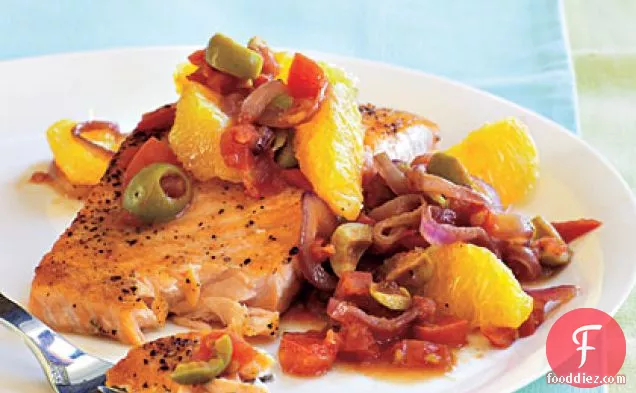Tomato-Citrus Salmon

Tomato-Citrus Salmon might be just the main course you are searching for. This recipe covers 31% of your daily requirements of vitamins and minerals. One serving contains 311 calories, 35g of protein, and 12g of fat. This recipe serves 4. A mixture of onion, salmon fillets, salt, and a handful of other ingredients are all it takes to make this recipe so yummy. To use up the salt you could follow this main course with the Apple Turnovers Recipe as a dessert. It is a good option if you're following a gluten free, dairy free, and primal diet.
Instructions
1
Grate 1/2 teaspoon orange rind; squeeze 1/4 cup juice from 1 orange into a sieve over a bowl. Section remaining 2 oranges to equal 1 cup sections.
Ingredients you will need![Orange Zest]() Orange Zest
Orange Zest![Orange]() Orange
Orange![Juice]() Juice
Juice
Equipment you will use![Sieve]() Sieve
Sieve![Bowl]() Bowl
Bowl
2
Sprinkle 1/4 teaspoon salt and 1/4 teaspoon freshly ground black pepper over fish.
Ingredients you will need![Ground Black Pepper]() Ground Black Pepper
Ground Black Pepper![Fish]() Fish
Fish![Salt]() Salt
Salt
3
Heat a large nonstick skillet over medium-high heat. Coat pan with cooking spray.
Ingredients you will need![Cooking Spray]() Cooking Spray
Cooking Spray
Equipment you will use![Frying Pan]() Frying Pan
Frying Pan
4
Add fish, top side down, to pan; cook 5 minutes.
Ingredients you will need![Fish]() Fish
Fish
Equipment you will use![Frying Pan]() Frying Pan
Frying Pan
6
Add onion to pan; saut 3 minutes or until tender and lightly browned.
Ingredients you will need![Onion]() Onion
Onion
Equipment you will use![Frying Pan]() Frying Pan
Frying Pan
7
Add tomato, olives, orange juice, and orange rind to pan; cook for 3 minutes, stirring occasionally. Stir in 1/8 teaspoon salt and 1/4 teaspoon freshly ground black pepper. Arrange fish, browned side up, over tomato mixture in pan. Cover, reduce heat, and simmer 3 minutes.
Ingredients you will need![Ground Black Pepper]() Ground Black Pepper
Ground Black Pepper![Orange Juice]() Orange Juice
Orange Juice![Orange Zest]() Orange Zest
Orange Zest![Olives]() Olives
Olives![Tomato]() Tomato
Tomato![Fish]() Fish
Fish![Salt]() Salt
Salt
Equipment you will use![Frying Pan]() Frying Pan
Frying Pan
Ingredients
Recommended wine: Chardonnay, Pinot Noir, Sauvignon Blanc
Salmon can be paired with Chardonnay, Pinot Noir, and Sauvignon Blanc. To decide on white or red, you should consider your seasoning and sauces. Chardonnay is a great friend to buttery, creamy dishes, while sauvignon blanc can complement herb or citrus-centric dishes. A light-bodied, low-tannin red such as the pinot noir goes great with broiled or grilled salmon. The Foley Estate Winery Sta. Rita Hills Chardonnay with a 4.3 out of 5 star rating seems like a good match. It costs about 27 dollars per bottle.

Foley Estate Winery Sta. Rita Hills Chardonnay
Rancho Santa Rosa Vineyard was originally conceived as individual micro-vineyards delineated into 59 unique blocks based upon soil, exposure, elevation, grade, rootstock and clone. Rancho Santa Rosa produces remarkably rich and silky wines.DifficultyMedium
Ready In35 m.
Servings4
Health Score99
Related recipes
Cherry-Apple Lattice Pie
Garlicky Green Beans
Turkey with Country Ham Stuffing
Striped Tuile Rolls
Magazine

Your Inner Chef with Taylor Swift's Top 3 Recipes from Her Beloved NYC Hangout

20 Mouthwatering Recipes You Need to Try Today!

Master the Art of Making Perfect Pancakes with This Foolproof Recipe

The Science Behind Red Wine: Its Surprising Health Benefits and Potential Risks

12 Wine Cocktails for a Sophisticated Twist

Sip, Swirl, and Celebrate: Toasting to National Wine Day on May 25th

National Drink Wine Day on February 18

Celebrating Souffle Day with Delectable Delights

Indulge in the Delightful Flavor of Oyster Soup on Its Special Day!

Celebrating World Nutella Day

How to Cook Chicken Breast in a Pan

How to Cook Eggs: 10 Ways!

How to Cook Like a Chef

How to Fry an Egg

How to Prep and Eat a Cactus Pear

6 Black Food Ideas

8 Healthy Early Winter Recipes

9 Best Winter Recipes

10 Super Cozy Slow Cooker Recipes to Make This Winter

15 Delicious Things You Should Eat In December

Your Inner Chef with Taylor Swift's Top 3 Recipes from Her Beloved NYC Hangout

20 Mouthwatering Recipes You Need to Try Today!

Sip, Swirl, and Celebrate: Toasting to National Wine Day on May 25th

National Drink Wine Day on February 18

Indulge in the Delightful Flavor of Oyster Soup on Its Special Day!

These Super Recipes for Your Football Party!

The Secrets Behind 3 Classic Comfort Food Recipes

Recipes to Spice Up Your February Menu

Top 20+ Must-Try Recipes Dominating February 2024










